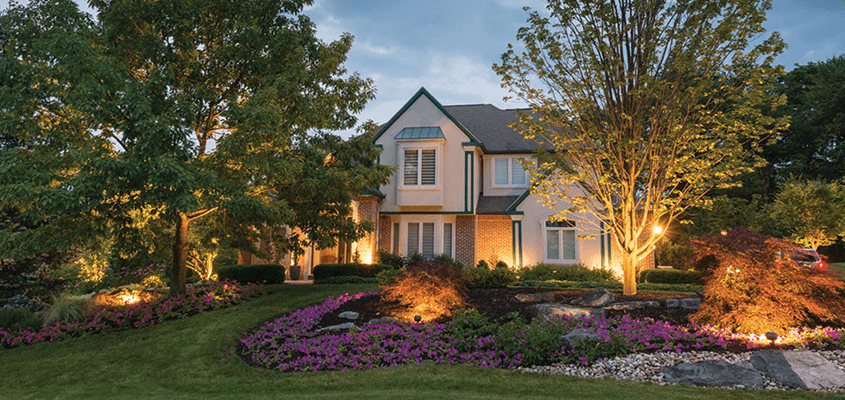
The yard and architectural features of a property, regardless of its size, can be a source of great pride, and for a good reason: it’s your place of solitude where you can relax and enjoy. So why should you only relish in this essential part of your home during the day?
Landscape lighting, with its vast array of products and applications, is a surefire way to improve your property and increase the enjoyment of your green spaces, whether you’re inside or outside. However, lighting up your outdoor landscape is crucial for you to enjoy the scenic investment at night too.
There is no limit to the number of ways you can add magic to your nighttime yard with outdoor lighting effects.
With help from landscaping experts, here are some advantages to lighting up your landscape.
Also read: All You Need To Know About Landscape Lighting For Your Yard
Moonlighting
Fixtures are placed high in a tree and aimed downward to create this lighting effect. This is an excellent way to illuminate a patio. Install multiple fixtures high in the tree branches to cast crosslights on the hardscape below. The tree’s leaves and branches cast fascinating shadows on the patio and pathways, simulating the effect of a full moon-lit sky.
Flood Lighting
Floodlights are the most effective type of outdoor landscape lighting for lighting up large areas. They are high-brightness spotlights with a wide coverage range. From above, they frequently illuminate driveways and patios.
Up-Lighting
This outdoor lighting technique employs low-voltage light fixtures outfitted with halogen or led bulbs to illuminate a tree from the ground up, highlighting its shape and trunk structure. Place 1-2 fixtures at the tree’s base and point upwards to highlight the main trunk structure.
Place a fixture 8-10 feet away from the trunk to capture the canopy of trees and highlight the branches and leaves. It is preferable to use fixtures with convex lenses so that irrigation water runs off the lens.
Silhouetting
Spread light is positioned between plant material, sculpture, fountain, or an adjacent structure to achieve this effect. As a result, the object is silhouetted in black against a soft white background.
Typically, spread lights are bi-pin halogen bulbs with a mirrored background. They produce a broad band of new white light, ideal for creating a silhouette effect by backlighting a wall, house, or structure. Multiple fixtures may be required depending on how much of the wall you need to illuminate.
Shadowing
This technique draws attention to the textures, shapes, and height differences of plant bed items, adding depth and ambiance.
The interaction of light and darkness can be particularly captivating, especially when the breeze affects the object. Lighting an object from below and angling it upward can create a larger-than-life dramatic effect.
Grazing
Use this technique to add depth and dimension to a home’s or building’s stucco, brick, stonework, or architectural features.
Spread lights or up lights are placed next to the wall with beams directed upwards to highlight a mesmerizing texture or stone work. This creates delicate shadows that capture the texture of the wall. This effect is fantastic for highlighting your stonework on walls and pilasters. When properly planned, grazing and silhouetting can coexist.
Cross Lighting
This feature is lit from both sides. You don’t want to overdo this effect because it can result in overlighting and a washed-out appearance. However, when used correctly, cross-lighting can highlight and soften your garden’s look. On walls and structures, shadows can be larger than life.
These lighting techniques truly elevate and transcend the look of your outdoors to the next level. It is imperative to hire a professional landscaping company to accentuate your outdoors with unique lighting techniques.
Structure Downlighting
Downlighting can be used in a variety of applications. To downlight patios and pathways, fixtures are placed in patio covers, under eaves of the house roof line, on garden walls, or in trees.
Downlighting can be used to highlight a flower bed or a beautiful plant. Hang or fix the light high enough to cast a circle of light around the feature you want to highlight. If that isn’t an option, consider a light that can create the desired size circle. Downlighting can also illuminate doorways and other entry and exit points.
Pathway Lights & Spread
Light up sidewalks, stone pathways, and lawn walkways while adding interest to boulders and plant beds. Spread lighting illuminates your plants by placing a path light inside a landscape bed.
About Burloak Landscaping
Burloak Landscaping is an accredited landscape company that strives to provide value for your money. We have been in the landscape industry for a long time, and our commitment to providing high-quality services to our clients is what keeps us going. We have a trained landscape crew with over 30 years of combined experience in the industry. Learn more about Burloak Landscaping.
Ready to invest in an interlocking driveway? Contact us today for landscaping services.






